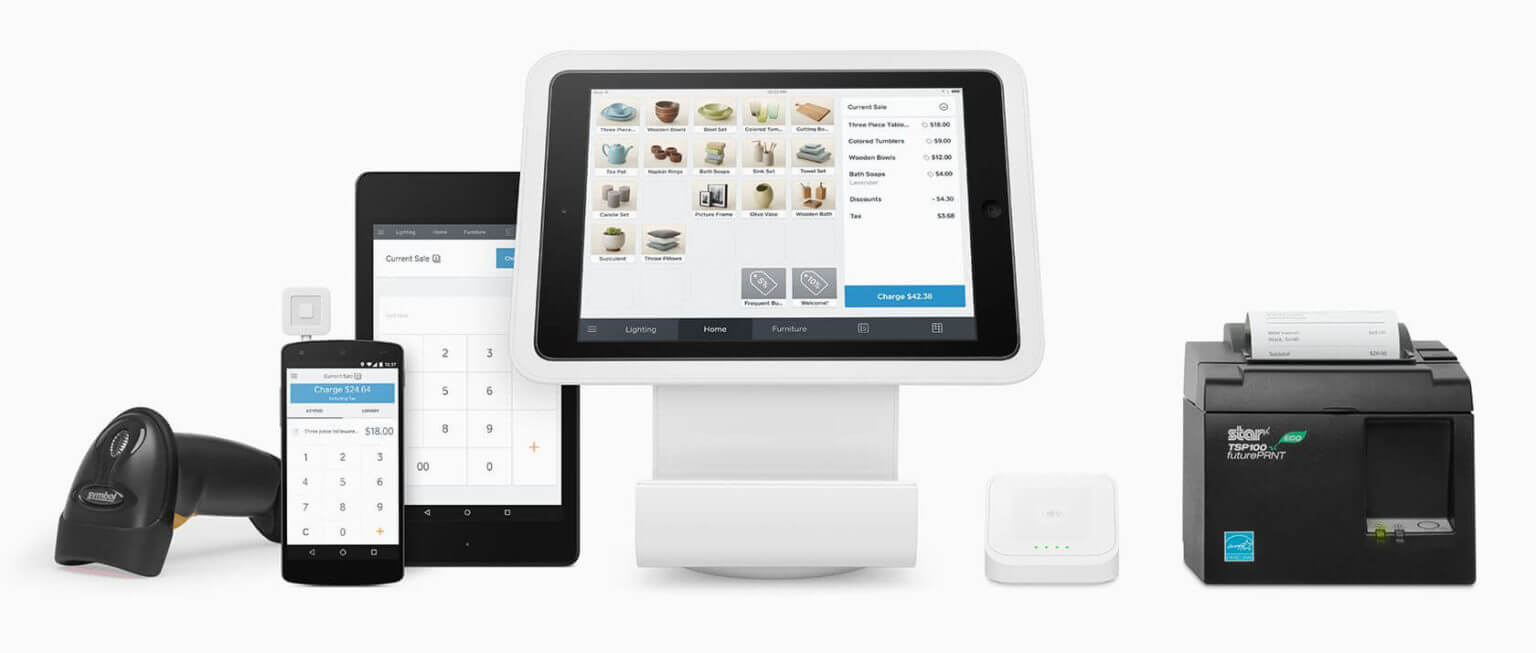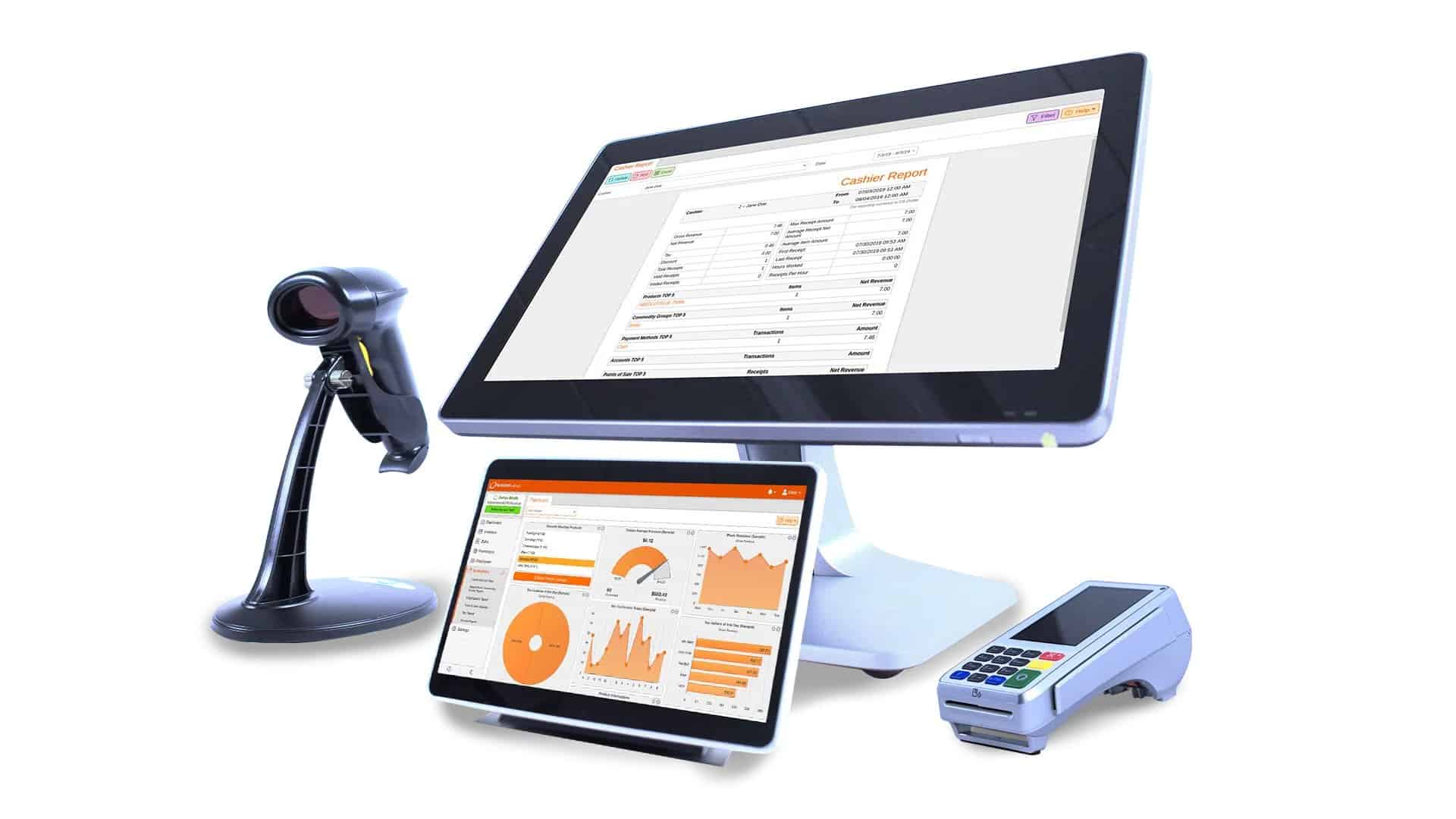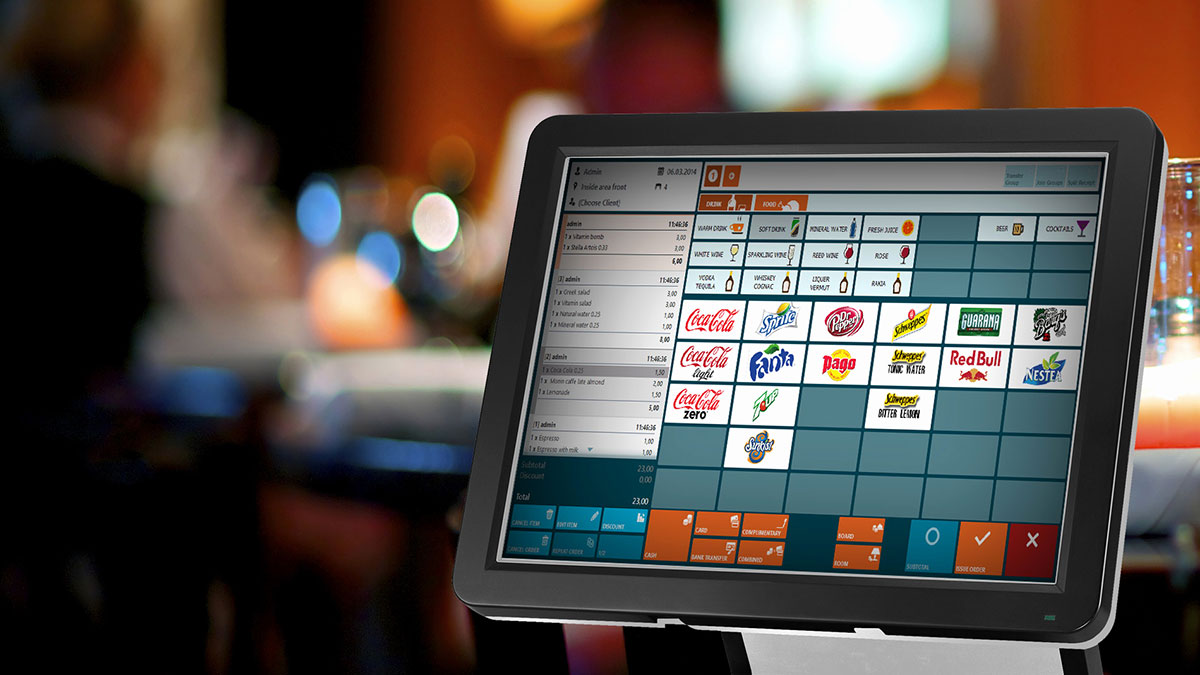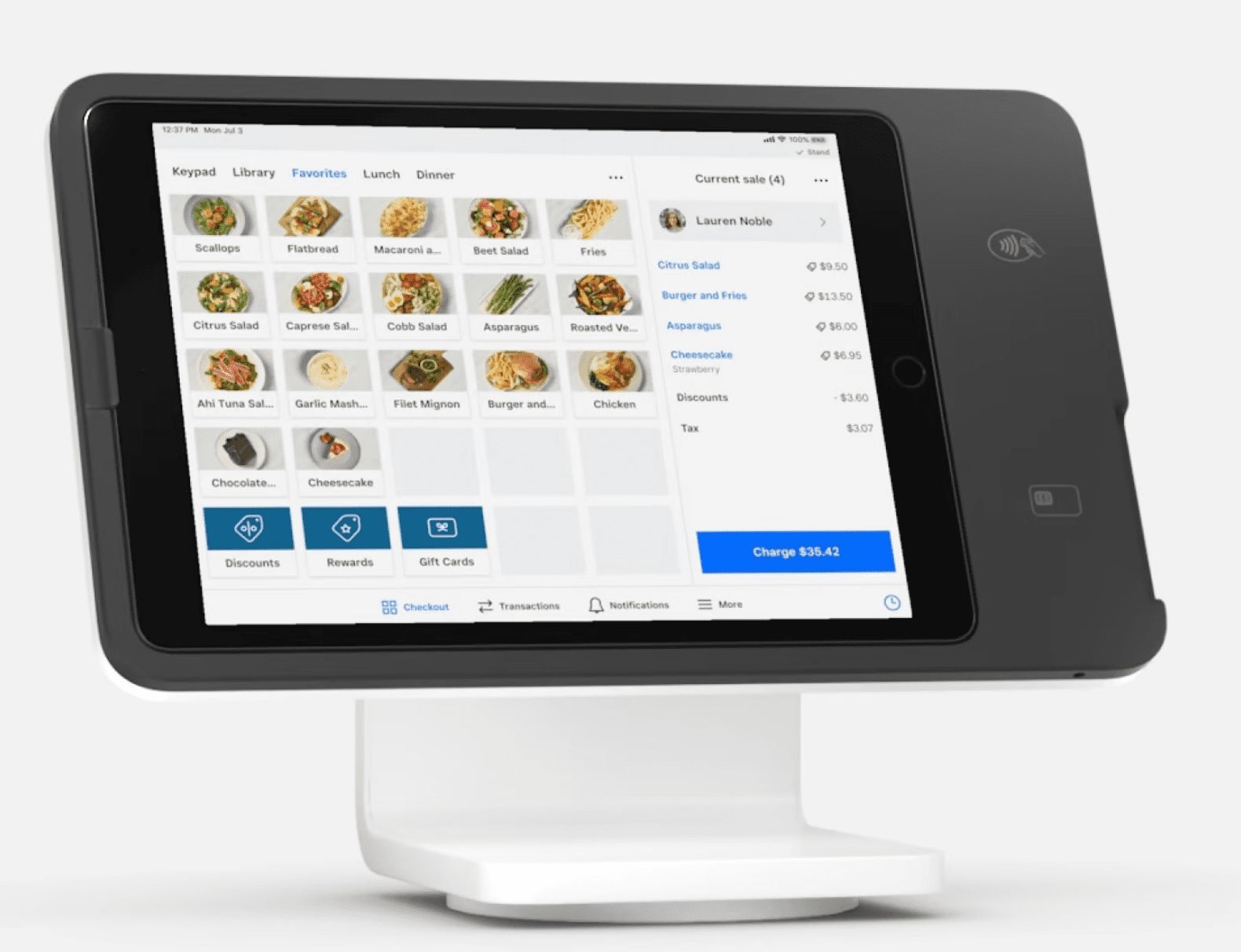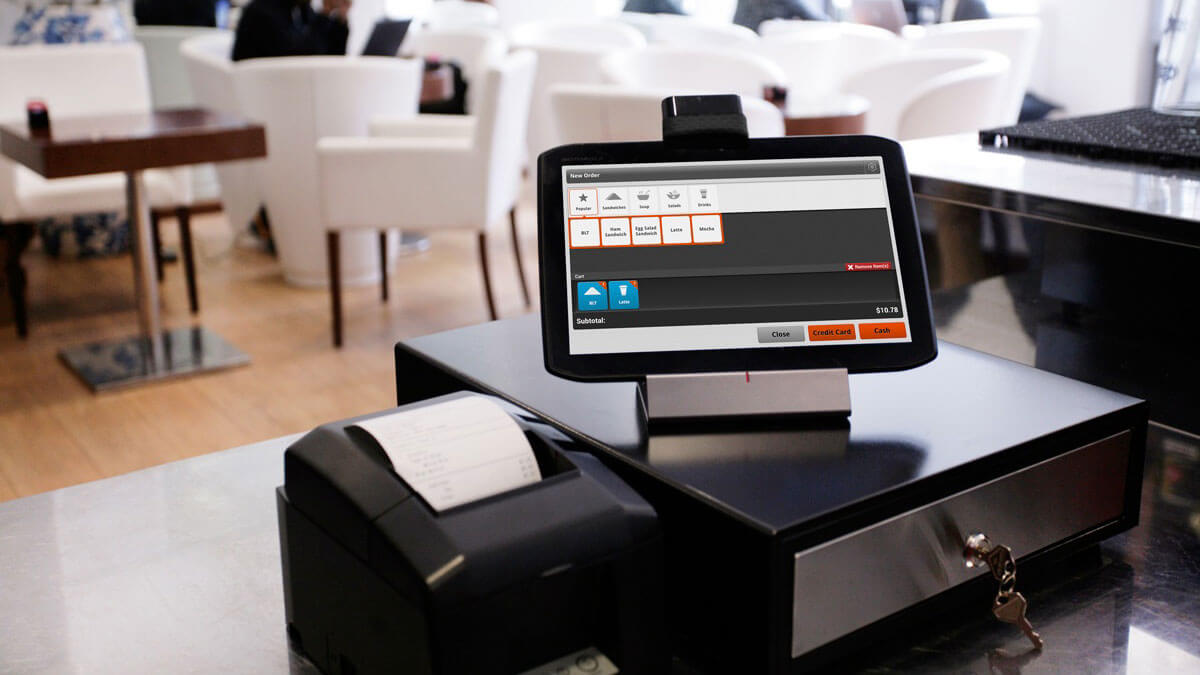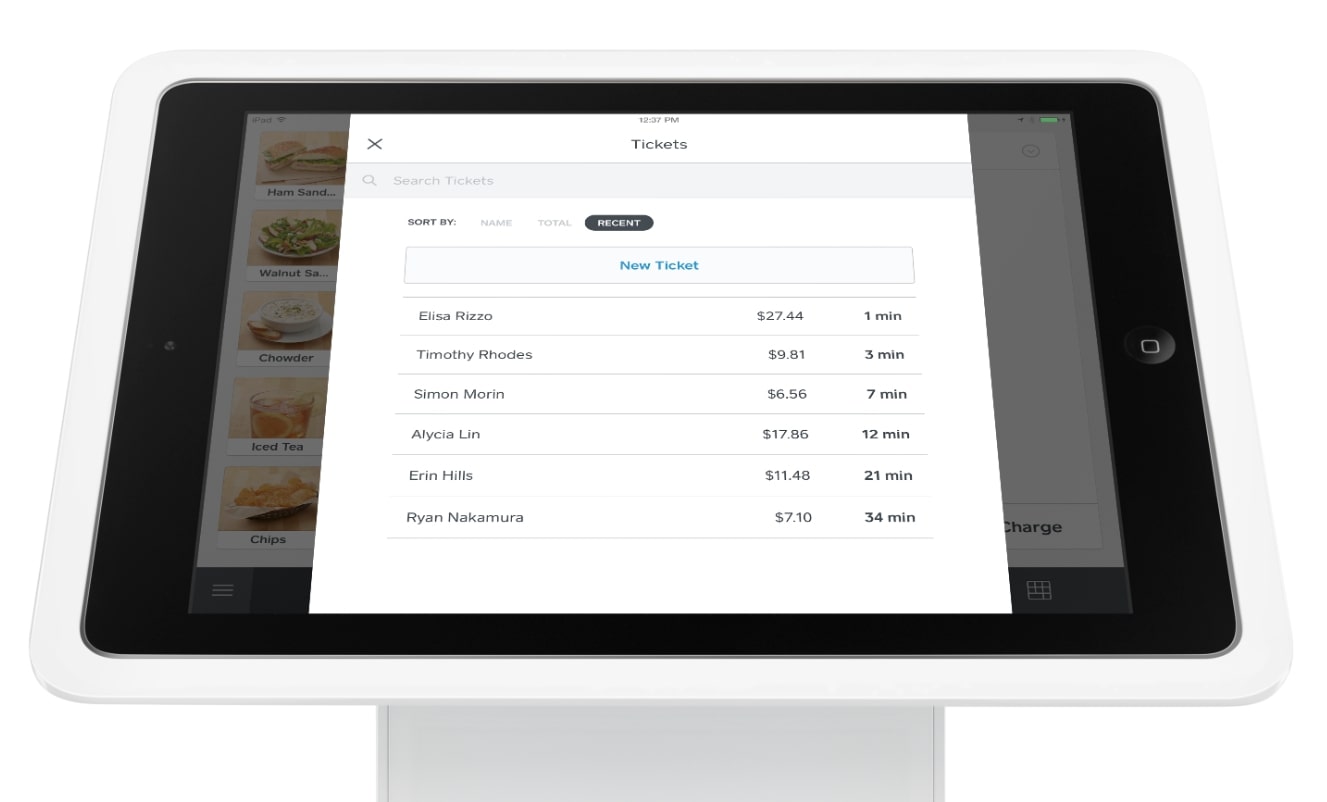Introduction
A Point of Sale (POS) system is an essential tool for businesses of all sizes and industries. Whether you’re running a retail store, a restaurant, or an online business, a POS system can revolutionize the way you manage your sales process.
Modern businesses rely on POS systems to streamline their operations, enhance customer experience, and improve overall efficiency. By seamlessly integrating hardware, software, and payment processors, these systems enable businesses to process transactions, manage inventory, generate reports, and more.
In this article, we will explore the intricacies of how a POS system works and delve into its key components. We will also discuss the step-by-step process of using a POS system to complete a sale, as well as the benefits of implementing one for your business.
So, whether you’re a business owner considering implementing a POS system or simply curious about how they work, read on to discover the ins and outs of this indispensable tool.
What is a POS system?
A Point of Sale (POS) system is a combination of hardware and software that allows businesses to process customer transactions at the point of purchase. It serves as the central hub for conducting and managing sales, inventory, and customer data.
Traditionally, a cash register was used to ring up sales, calculate totals, and store cash. However, with advancements in technology, POS systems have become much more sophisticated and versatile.
Today’s POS systems are often comprised of a computer, touchscreen monitor, barcode scanner, cash register, receipt printer, and other peripherals. The software component of a POS system enables businesses to track and record sales data, manage inventory, generate reports, and integrate with other business applications.
In addition to processing sales, a POS system can also handle other functions such as managing employee schedules, tracking customer information, and processing returns or exchanges.
Furthermore, with the rise of mobile and cloud-based solutions, businesses can now access their POS system on smartphones and tablets, offering even greater flexibility and convenience.
In essence, a POS system acts as the backbone of a business’s operations, providing a seamless and efficient way to manage sales and customer data, track inventory, and analyze business performance.
Components of a POS System
A Point of Sale (POS) system is made up of several key components that work together to facilitate the sales process and provide valuable business insights. These components include hardware, software, and a payment processor.
1. Hardware:
The hardware component of a POS system typically includes a computer or tablet, a touchscreen monitor, a barcode scanner, a cash register, a receipt printer, and other peripherals such as a customer display or a card reader. These devices are essential for inputting and processing sales transactions.
2. Software:
The software component of a POS system is the brain behind the operation. It enables businesses to manage sales, inventory, and customer data efficiently. Depending on the specific needs of the business, the software can include features such as product catalog management, sales reporting, inventory tracking, employee management, and customer relationship management.
In addition, many POS systems offer integrations with other business tools such as accounting software, e-commerce platforms, or loyalty programs, allowing for seamless data transfer and enhanced functionality.
3. Payment Processor:
A payment processor is an essential component of a POS system as it enables businesses to accept and process various forms of payment, such as credit cards, debit cards, mobile payments, or even cash. The payment processor securely handles the transaction and ensures that funds are transferred to the business’s account.
In some cases, the payment processor may be separate from the POS system, and businesses will need to set up a merchant account or work with a payment gateway to process transactions. However, many modern POS systems offer integrated payment processing, simplifying the setup and providing a seamless payment experience for both the business and the customer.
By combining these three components – hardware, software, and payment processor – a POS system provides businesses with a comprehensive solution for managing their sales process, tracking inventory, and processing payments efficiently.
Hardware
The hardware component of a Point of Sale (POS) system plays a vital role in facilitating the sales process and providing a seamless customer experience. It includes various devices and peripherals that are essential for inputting and processing sales transactions.
Here are some key hardware components commonly found in a POS system:
– Computer or Tablet: The central hub of the POS system is often a computer or tablet, which runs the software necessary for processing sales transactions and managing other aspects of the business.
– Touchscreen Monitor: A touchscreen monitor allows for easy navigation and input, enabling cashiers to select items, apply discounts, and process payments with a simple touch.
– Barcode Scanner: A barcode scanner is used to quickly and accurately scan the barcodes on products, retrieving essential information such as item details, pricing, and stock levels. This helps expedite the checkout process and minimize errors.
– Cash Register: Although electronic cash registers are not as common as they used to be, some businesses still prefer to have a cash drawer as part of their POS system. It provides a convenient place to store cash and manage monetary transactions if customers choose to pay with cash.
– Receipt Printer: A receipt printer is used to generate detailed receipts for customers, providing a record of their purchase. This is not only important for customer satisfaction but also for accounting and inventory purposes.
– Customer Display: Some businesses choose to include a customer display screen, which allows customers to see the items being scanned, the total amount due, and other relevant information. This helps improve transparency and ensures accuracy.
– Card Reader: A card reader is crucial for businesses that accept debit and credit card payments. It securely reads the card information, encrypts it, and communicates with the payment processor to authorize and process the transaction.
In addition to these core components, a POS system may include other peripherals such as a cash drawer, a keyboard, a mouse, or even a receipt roll holder. The specific hardware setup will depend on the needs and preferences of the business.
By investing in the right hardware components, businesses can create an efficient and reliable POS system that speeds up transactions, reduces errors, and enhances the overall customer experience.
Software
The software component of a Point of Sale (POS) system plays a crucial role in managing and organizing the sales process, inventory, and customer data. It provides businesses with the necessary tools to streamline operations, track sales, and make informed decisions. Here are some key aspects of POS software:
– Sales Management: The software allows businesses to process sales transactions efficiently. It enables cashiers to input items, scan barcodes, apply discounts or promotions, and calculate the final total. It also generates detailed receipts for customers, including itemized lists and payment information.
– Inventory Tracking: POS software provides businesses with real-time visibility into their inventory levels. It tracks stock quantities, alerts when items need to be reordered, and provides insights on popular products. This helps businesses avoid stockouts, optimize their inventory, and improve overall efficiency.
– Product Management: POS software allows businesses to easily manage their product catalog. It includes functionalities such as adding or removing products, categorizing items, setting pricing, and updating product information. This ensures that accurate and up-to-date data is used for sales and inventory purposes.
– Reporting and Analytics: POS software generates reports and analytics to provide valuable insights into business performance. It can generate sales reports, inventory reports, and customer analytics to help businesses make data-driven decisions. This information can be used to identify trends, evaluate the success of promotions, and assess overall business health.
– Employee Management: Some POS software includes features for managing employee schedules, tracking clock-in/out times, and monitoring sales performance. This allows businesses to efficiently manage their workforce and ensure smooth operations.
– Integration Capabilities: POS software often offers integration capabilities with other business tools. This enables businesses to connect their POS system with accounting software, customer relationship management (CRM) systems, e-commerce platforms, or loyalty programs. Integrated systems help streamline data flow, reduce manual work, and provide a more comprehensive view of the business.
– User-Friendly Interface: A good POS software should have a user-friendly interface, making it easy for employees to learn and use. Intuitive navigation, clear icons, and customizable features contribute to a smoother and more efficient sales process.
Choosing the right POS software for your business is crucial for optimizing operations, improving customer service, and gaining insights into your business’s performance. It’s important to consider factors such as the scalability of the software, its compatibility with your hardware, and the level of support provided by the software provider.
Payment Processor
The payment processor is a vital component of a Point of Sale (POS) system’s functionality. It enables businesses to securely process various forms of payment, such as credit cards, debit cards, mobile payments, and even cash. Here’s a closer look at the payment processor component:
– Payment Options: A payment processor allows businesses to accept a wide range of payment methods, including traditional credit and debit cards. It may also support contactless payments, such as Near Field Communication (NFC) or mobile wallet payments like Apple Pay or Google Pay. By offering multiple payment options, businesses can cater to the preferences of different customers and enhance the overall buying experience.
– Authorization and Security: When a customer makes a payment, the payment processor securely communicates with the issuing bank or card network to authorize the transaction. It ensures that the payment details are valid, and sufficient funds are available. By encrypting sensitive customer information, payment processors help protect against fraud and maintain the security of the transaction.
– Integration with POS Software: A payment processor seamlessly integrates with the POS software, allowing businesses to process payments directly within the interface. This eliminates the need for separate card terminals or manual entry of payment details, saving time and reducing errors. The integration also ensures that accurate sales and inventory data are updated in real-time.
– Transaction Speed: A reliable payment processor facilitates fast and efficient transactions. The ability to process payments quickly not only enhances the customer experience but also reduces waiting times, especially during peak hours. Businesses can serve more customers, increase sales potential, and optimize overall operations.
– Settlement and Reconciliation: After processing a payment, the payment processor handles the settlement process, transferring the funds from the customer’s account to the business’s merchant account. It ensures a streamlined flow of funds and simplifies the reconciliation process, making it easier to monitor revenue and manage finances.
– Support and Customer Service: Payment processors often provide support for businesses, assisting with setup, troubleshooting, and addressing any payment-related issues. Reliable customer service ensures that businesses have access to assistance when needed, reducing downtime and ensuring smooth operations.
– Fees and Pricing: Payment processors may charge various fees for their services, such as transaction fees or monthly fees. It’s essential for businesses to understand the pricing structure and compare different payment processors to find the one that offers the best value for their specific needs.
– Compliance and Regulations: Payment processors adhere to strict industry regulations, such as the Payment Card Industry Data Security Standard (PCI DSS). Compliance ensures that businesses meet the necessary security requirements and adhere to industry best practices when handling sensitive customer payment data.
Choosing the right payment processor for your POS system is critical for ensuring secure and efficient transactions. Consider factors such as transaction fees, supported payment methods, customer service quality, and compatibility with your business’s existing infrastructure.
How does a POS system work?
A Point of Sale (POS) system is designed to simplify the sales process and provide businesses with the means to efficiently process transactions and manage inventory. Here’s a step-by-step overview of how a typical POS system works:
1. Scanning Products: The cashier uses a barcode scanner to scan the barcodes on products. The scanner reads the barcode and retrieves the product information from the POS software, such as the product name, price, and stock level.
2. Adding Items to the Cart: After scanning each item, the POS system adds it to the customer’s cart. The software keeps a running total of the items, applying any discounts or promotions that may be applicable.
3. Applying Discounts and Promotions: If there are any discounts or promotions available, the cashier can easily apply them to the customer’s purchase. The POS software calculates the discounted prices and updates the total accordingly.
4. Processing Payments: Once the customer’s shopping is complete, the payment process begins. The cashier selects the preferred payment method, such as credit card, debit card, or cash, and the POS system securely processes the transaction. For card payments, the customer may swipe or insert their card into a card reader connected to the POS system, while for cash payments, the cashier enters the amount received and calculates the change.
5. Generating Receipts: After the payment is successfully processed, the POS system generates a detailed receipt for the customer. The receipt includes information such as the items purchased, their prices, any discounts applied, and the payment method. This provides a record of the transaction for both the customer and the business.
6. Managing Inventory: As each product is scanned and added to the sales transaction, the POS system automatically updates the inventory levels in real-time. This ensures accurate tracking of stock, helping businesses to know when to restock items and avoid running out of popular products.
A well-designed POS system streamlines the sales process, reduces manual errors, and provides businesses with valuable insights into their operations. With features such as inventory tracking, sales reporting, and integration capabilities, businesses can efficiently manage their sales, inventory, and customer data, contributing to improved efficiency and customer satisfaction.
Scanning Products
One of the fundamental steps in the sales process of a Point of Sale (POS) system is scanning products. The scanning process involves using a barcode scanner to read the barcodes on items and retrieve the relevant information needed for the transaction. Here’s a closer look at how scanning products works within a POS system:
– Barcode Scanning: The cashier or sales associate uses a barcode scanner, which can be handheld or built into the POS system, to scan the barcode found on each product. The barcode scanner emits a laser or LED light that reads the encoded lines or dots on the barcode. This information is then passed on to the POS software for processing.
– Product Identification: When the barcode scanner reads the barcode, it identifies the corresponding product within the POS software’s database. The database includes information about the product, such as its name, price, SKU or item code, and any additional details specified by the business.
– Retrieving Product Information: Once the barcode scanner identifies the product, the POS system retrieves the relevant product information and displays it on the user interface. This information is crucial for accurately processing the sales transaction and generating an itemized receipt for the customer.
– Pricing and Stock Validation: The POS system not only retrieves the product information but also verifies the pricing and stock availability in real-time. It ensures that the correct price is associated with the scanned product and provides a warning or error message if the stock level is low or if the product is out of stock. This feature helps prevent pricing errors and allows businesses to manage their inventory effectively.
– Discounts and Promotions: The POS system can be programmed to recognize any discounts or promotions associated with specific products. If a discount or promotion is applicable, it is automatically applied to the scanned item, updating the final price instantly. This feature ensures accuracy and consistency in applying discounts, saving time and effort for both the cashier and the customer.
Scanning products within a POS system not only expedites the sales process but also improves accuracy and reduces human errors. By leveraging barcode scanning technology, businesses can ensure efficient and precise product identification, pricing, and inventory management, ultimately enhancing the overall customer experience.
Adding Items to the Cart
Once products have been scanned, the Point of Sale (POS) system proceeds to the next step: adding items to the cart. This step involves aggregating the scanned products, applying any applicable discounts or promotions, and updating the total amount due. Here’s a closer look at how adding items to the cart works within a POS system:
– Itemized Listing: As each product is scanned, the POS system creates an itemized listing in the cart. The listing includes details such as the product name, quantity, price per unit, and any additional information that the business has associated with the product.
– Running Total: The POS system keeps a running total of the items as they are added to the cart. This allows the cashier to provide the customer with an accurate subtotal throughout the transaction, improving transparency and ensuring that there are no surprises at the end.
– Discounts and Promotions: If there are any discounts or promotions applicable to the items being added to the cart, the POS system automatically applies them. This ensures that customers receive any savings or benefits they are entitled to, without requiring manual adjustment from the cashier.
– Quantity Adjustments: In some cases, customers may want to purchase multiple units of the same product. The POS system allows for easy adjustment of quantities, enabling the cashier to increase or decrease the quantity as needed. This feature improves convenience and flexibility in the sales process.
– Real-time Updates: As items are added or removed from the cart, the POS system updates the inventory levels in real-time. This ensures accurate tracking and prevents the sale of products that are out of stock or nearing depletion. Real-time updates also provide valuable business insights for inventory management and purchase planning.
– Visual Display: The POS system usually displays a clear and organized summary of the items in the cart, making it easy for both the cashier and the customer to review the purchase. This visual display helps minimize errors and ensures that the correct items are accounted for in the final transaction.
Adding items to the cart within a POS system streamlines the sales process, eliminates manual calculations, and ensures accuracy in pricing and inventory management. By automating the process of aggregating items and updating the total, businesses can enhance the efficiency of their transactions and create a seamless experience for both customers and cashiers.
Applying Discounts and Promotions
Applying discounts and promotions is an essential part of the sales process in a Point of Sale (POS) system. It allows businesses to offer special pricing to customers and incentivize purchases. Here’s a closer look at how discounts and promotions are applied within a POS system:
– Automatic Calculation: When a discount or promotion applies to a specific item or group of items, the POS system automatically calculates the adjusted price. This eliminates the need for manual calculations and ensures accuracy in pricing.
– Percentage Discounts: A common type of discount is a percentage off the original price. For instance, if a customer receives a 20% discount on a $50 item, the POS system calculates the discounted price as $40. The POS system deducts the discount amount from the original price and displays the discounted price to the cashier and the customer.
– Fixed Amount Discounts: Another type of discount is a fixed amount deduction from the original price. For example, if a customer receives a $10 discount on a $75 item, the POS system subtracts $10 from the original price, resulting in a final price of $65.
– Promotional Bundles: Some promotions involve bundling multiple products together at a discounted price. With a POS system, businesses can define and apply promotional bundles easily. The system recognizes the bundled items and automatically adjusts the price to reflect the discount, providing a seamless customer experience.
– Coupon Codes: POS systems often allow businesses to generate and scan coupon codes. When a customer presents a valid coupon code, the system validates it and applies the associated discount automatically. This simplifies the redemption process and ensures that discounts are applied correctly.
– Time-based Promotions: Businesses may run time-limited promotions, such as weekend sales or holiday discounts. The POS system allows the business to set up these promotions with specified start and end dates. As the promotion period begins, the system applies the discounted prices automatically during that timeframe.
– Loyalty Programs: POS systems may integrate with loyalty programs, allowing businesses to reward loyal customers with special discounts or points. When a customer presents their loyalty card or provides their loyalty account information, the POS system identifies them as a member and applies any eligible discounts or rewards.
Applying discounts and promotions within a POS system streamlines the sales process, improves customer satisfaction, and helps businesses attract and retain customers. By automating the calculation and application of discounts, businesses can ensure accuracy, minimize errors, and create a positive shopping experience for their customers.
Processing Payments
Processing payments is a critical step in the sales process of a Point of Sale (POS) system. It involves securely and efficiently accepting various forms of payment from customers. Here’s a closer look at how the payment processing works within a POS system:
– Payment Options: A POS system is equipped to accept multiple forms of payment, including credit cards, debit cards, mobile wallets, and cash. When it comes time for the customer to pay, the cashier selects the appropriate payment method that the customer prefers.
– Card Payments: For card payments, the customer can either insert their chip card into a card reader or swipe their magnetic stripe card. The POS system securely reads the card information and transmits it to the payment processor for authorization.
– Contactless Payments: Some POS systems also support contactless payments, such as Near Field Communication (NFC) or mobile wallet payments like Apple Pay or Google Pay. Customers can simply tap their mobile devices or contactless cards near the POS system’s card reader to complete the payment.
– Cash Payments: If the customer wishes to pay in cash, the cashier enters the amount received from the customer into the POS system. The system calculates the change due and displays it for the cashier to provide to the customer.
– Authorization and Security: Once the payment information is received by the POS system, it securely communicates with the payment processor to authorize the transaction. The payment processor confirms the validity of the payment details and checks if sufficient funds are available. This verification process helps mitigate the risk of fraud and ensures a secure transaction.
– Transaction Confirmation: After the payment is authorized, the POS system provides confirmation of the successful transaction to both the cashier and the customer. It may display a receipt on the screen or generate a printed receipt, depending on the business’s setup and customer preference.
– Integration with Receipt Printer: In scenarios where a printed receipt is required, the POS system seamlessly integrates with a receipt printer. The printer generates a detailed receipt that includes information such as the items purchased, the payment method, and the transaction timestamp.
– Settlement: The payment processor finalizes the transaction by transferring the funds from the customer’s account to the business’s merchant account. This settlement process typically occurs within a designated timeframe, depending on the terms and conditions agreed upon with the payment processor.
– Payment Verification: The POS system verifies the successful settlement of the transaction, ensuring that the funds have been transferred and that the sale is officially recorded in the business’s financial records.
Processing payments within a POS system streamlines the checkout process, improves the speed and security of transactions, and provides a seamless experience for both the customer and the business. By supporting various payment options and integrating with secure payment processors, businesses can offer convenience and flexibility to their customers while ensuring accurate financial management.
Generating Receipts
Generating receipts is a crucial aspect of a Point of Sale (POS) system. It provides customers with a detailed record of their purchase and serves as proof of transaction. Here’s a closer look at how receipt generation works within a POS system:
– Automatic Receipt Generation: After a transaction is completed, the POS system automatically generates a receipt. This can be in either digital or printed format, depending on the business’s preferences and setup.
– Itemized Purchase Details: The receipt includes an itemized list of the products or services purchased. Each item is listed with its name, quantity, price, and any applicable discounts. This detailed information helps customers verify their purchase and provides transparency in the transaction.
– Payment Information: The receipt also includes information regarding the payment method used. It specifies whether the payment was made via cash, credit card, debit card, or any other applicable form of payment. This information ensures that customers have a record of how the payment was processed.
– Transaction Total: The receipt displays the total amount paid by the customer, including any taxes, discounts, or additional charges. It shows the breakdown of the subtotal, taxes, and the final amount due. This transparency helps customers understand the pricing and feel confident in their purchase.
– Visual Design and Branding: Receipts generated by a POS system often feature the business’s branding, including the company name, logo, and contact information. This creates a cohesive and professional image and allows customers to easily identify the source of the receipt.
– Return and Exchange Information: In some cases, receipts may include return and exchange policies or instructions. This information informs customers about their rights and options for returning or exchanging products if needed.
– Digital Receipts: In addition to or instead of printed receipts, many POS systems offer the option to provide digital receipts. These receipts can be emailed to the customer or sent via text message. Digital receipts are convenient for customers who prefer to have an electronic record of their purchase.
– Business Reporting: The POS system uses receipt data to generate sales reports and analytics for businesses. This information helps businesses evaluate their performance, track trends, and make informed decisions regarding sales strategies, product offerings, and inventory management.
Generating receipts within a POS system not only provides customers with a record of their purchase but also helps businesses maintain accurate financial records and gain insights into their operations. By providing clear and detailed receipts, businesses can enhance customer satisfaction, improve transparency, and streamline their business processes.
Managing Inventory
Effective inventory management is crucial for the success of any business, and a Point of Sale (POS) system plays a significant role in managing and tracking inventory. Here’s a closer look at how inventory management works within a POS system:
– Real-Time Updates: As products are scanned and added to a sales transaction, the POS system updates the inventory levels in real-time. This ensures accurate and up-to-date information regarding the availability of products.
– Stock Tracking: The POS system keeps track of the quantity of each product in stock. It monitors when items are sold, returned, or added to the inventory. By maintaining accurate stock levels, businesses can prevent stockouts and avoid overstocking, optimizing the use of their resources.
– Low Stock Alerts: When products reach a specified threshold, the POS system can alert the business to reorder or restock those items. This feature helps streamline inventory management and ensures that businesses have sufficient stock on hand to meet customer demand.
– Advanced Inventory Capabilities: Some POS systems offer advanced inventory management features such as organizing products into categories, setting reorder points, and tracking stock across multiple store locations or warehouses. These features provide businesses with a comprehensive view of their inventory and enable better control and planning.
– Product Variants and Attributes: For businesses that sell products with different variations, such as size, color, or style, the POS system can manage and track inventory for each variant. This ensures accuracy in stock levels and prevents overselling or confusion among different variants.
– Automated Purchase Orders: POS systems with integrated inventory management functionality can automatically generate purchase orders based on predefined reorder points or low stock alerts. This streamlines the purchasing process and reduces manual effort for businesses.
– Product Performance Analysis: POS systems can generate reports and analytics related to product performance. These reports provide valuable insights into which products sell well and which might be underperforming. This data helps businesses make informed decisions regarding product selection, pricing, and promotions.
– Integration with Suppliers and E-commerce Platforms: Some POS systems integrate with suppliers or e-commerce platforms, allowing businesses to manage supplier relationships and streamline inventory replenishment. This integration helps ensure a seamless flow of information and reduces manual work.
Effective inventory management within a POS system optimizes stock levels, prevents stockouts, enhances customer satisfaction, and reduces costs associated with overstocking or excess inventory. By providing businesses with real-time visibility into their inventory, POS systems enable efficient management, accurate reporting, and informed decision-making.
Benefits of Using a POS System
Implementing a Point of Sale (POS) system brings numerous benefits to businesses of all sizes and industries. From enhancing efficiency to providing valuable insights, here are some key advantages of using a POS system:
– Efficiency and Accuracy: A POS system streamlines the sales process by automating tasks such as scanning products, calculating totals, and processing payments. This reduces human errors and eliminates the need for manual calculations, ensuring accuracy and improving operational efficiency.
– Streamlined Sales Process: With a POS system, businesses can expedite the checkout process, minimizing waiting times and improving customer satisfaction. Features like barcode scanning, quick payment processing, and automatic receipt generation make the sales process more efficient and enjoyable for both customers and employees.
– Inventory Management: A POS system provides real-time tracking of inventory levels, allowing businesses to have precise visibility into stock quantities and locations. This helps manage stock levels effectively, preventing stockouts and overstocking. Robust inventory management features help optimize purchasing decisions and streamline the replenishment process.
– Sales Analytics: POS systems generate reports and analytics that provide valuable insights into business performance. Sales reports, product performance analysis, and customer purchasing patterns help businesses identify trends, evaluate the success of promotions, and make data-driven decisions to drive growth and improve profitability.
– Customer Relationship Management: By capturing customer data through a POS system, businesses can build and maintain strong customer relationships. POS systems often include features to manage customer information, track purchase history, and implement loyalty programs. This allows businesses to provide personalized service, targeted promotions, and enhance overall customer satisfaction.
– Employee Management: POS systems can assist with employee management tasks such as tracking employee sales, managing schedules, and monitoring performance. By seamlessly integrating employee management features, businesses can efficiently manage their workforce and optimize staffing levels based on sales demands.
– Integration Capabilities: POS systems often offer integration capabilities with other business tools and systems, such as accounting software, e-commerce platforms, loyalty programs, and more. This enables businesses to centralize data, streamline operations, reduce manual work, and gain a holistic view of their business performance.
– Enhanced Security: POS systems prioritize security measures to protect sensitive customer data and financial transactions. These systems are designed to comply with industry standards and often utilize encryption, tokenization, and other security protocols to safeguard information. This helps businesses and customers trust in the security of their transactions.
Implementing a POS system offers numerous benefits for businesses, including improved efficiency, streamlined sales processes, effective inventory management, data-driven decision-making, and enhanced customer relationships. By embracing the capabilities of a modern POS system, businesses can gain a competitive edge and position themselves for long-term success.
Efficiency and Accuracy
One of the significant benefits of using a Point of Sale (POS) system is the improvement in efficiency and accuracy that it brings to businesses. Here’s how a POS system enhances efficiency and accuracy:
– Automated Processes: A POS system automates time-consuming tasks such as scanning products, calculating totals, and processing payments. By eliminating the need for manual calculations, cashiers can serve customers more quickly, reducing waiting times and ensuring a smoother checkout experience.
– Minimized Human Errors: Manual calculations and data entry are prone to errors. With a POS system, human errors are significantly reduced. The system calculates totals accurately, applies discounts precisely, and records transactions correctly, avoiding mistakes that can lead to financial discrepancies and customer dissatisfaction.
– Faster Transaction Processing: POS systems with fast barcode scanners and integrated payment processors accelerate transaction processing. Cashiers can scan products rapidly, retrieve pricing information instantly, and complete payment transactions efficiently. This ensures a quick and seamless experience for both customers and employees.
– Automatic Inventory Updates: A POS system provides real-time inventory tracking and updates. When products are sold, the system automatically deducts the quantities from the inventory, providing accurate stock information. This eliminates the need for manual tracking and stock reconciliation, saving time and reducing the chances of inventory discrepancies.
– Simplified Reporting: POS systems generate detailed reports and analytics that provide valuable insights into sales performance, customer behavior, and inventory management. These reports are generated automatically, eliminating the need for manual data compilation and analysis. Managers can access real-time information, make informed decisions, and implement effective strategies to drive business growth.
– Enhanced Time Management: By automating routine tasks, a POS system allows employees to focus on delivering better customer service and performing other essential duties. Time that would have been spent on manual calculations, recording sales data, and managing inventory can now be redirected towards tasks that add value to the business.
– Streamlined Accounting: POS systems seamlessly integrate with accounting software, enabling accurate and streamlined financial management. Sales data is automatically recorded, eliminating the need for manual entry and reducing the chances of data discrepancies. This simplifies bookkeeping, improves accuracy in financial records, and expedites the accounting process.
Efficiency and accuracy are crucial for businesses to operate smoothly and provide exceptional customer experiences. By implementing a POS system, businesses can streamline processes, eliminate errors, improve productivity, enhance customer satisfaction, and ultimately, drive growth and success.
Streamlined Sales Process
A Point of Sale (POS) system offers businesses a streamlined sales process, simplifying and optimizing transactions from start to finish. Here are some ways in which a POS system enhances the sales process:
– Efficient Product Scanning: With a barcode scanner integrated into the POS system, items can be quickly and accurately scanned, significantly reducing the time it takes to process each transaction. This streamlined scanning process ensures efficient and error-free registration of products.
– Convenient Item Entry: POS systems often have user-friendly interfaces that allow cashiers to enter items manually, in case a barcode is missing or damaged. The system prompts cashiers to input necessary information such as the product name, price, and quantity, ensuring accurate and seamless item entry.
– Easy Discount and Promotion Application: Applying discounts and promotions is made simple with a POS system. Cashiers can easily select and apply discounts or promotional offers to the customer’s purchase, ensuring accurate pricing. This streamlines the process, eliminating the need for manual calculations and minimizing errors.
– Quick Payment Processing: POS systems expedite payment processing, resulting in shorter transaction times. Integrated payment processors enable swift and secure transactions, supporting various forms of payment including credit cards, debit cards, and mobile wallets. This efficiency minimizes customer waiting times and enhances the overall checkout experience.
– Automatic Receipt Generation: Once the payment is processed, a POS system automatically generates a detailed receipt that includes the purchased items, payment information, and any applicable discounts. This eliminates the need for manual receipt generation and ensures that customers receive a comprehensive record of their purchase.
– Seamless Integration with Other Systems: Many POS systems offer integration capabilities with other business systems such as inventory management, accounting, and customer relationship management (CRM) systems. This seamless integration allows for real-time data sharing and synchronization, reducing manual data entry and ensuring consistent and accurate information across various systems.
– Enhanced Customer Experience: By streamlining the sales process, a POS system enhances the overall customer experience. The efficiency and accuracy provided by POS systems minimize waiting times, reduce errors, and provide customers with a smooth and convenient purchasing experience. This leads to increased customer satisfaction and loyalty.
– Comprehensive Sales Reporting: POS systems generate reports and analytics that provide valuable insights into sales performance. Businesses can analyze sales trends, identify top-selling items, and evaluate the success of promotions. These insights enable informed decision-making, helping businesses optimize their product offerings, marketing strategies, and sales techniques.
A streamlined sales process offered by a POS system helps businesses save time, minimize errors, and improve customer satisfaction. By optimizing the sales process, businesses can focus on delivering exceptional service, boosting sales, and fostering long-term customer loyalty.
Inventory Management
Efficient inventory management is crucial for businesses to meet customer demands, reduce costs, and optimize operations. A Point of Sale (POS) system offers robust inventory management features that streamline the management and tracking of inventory. Here are some key benefits of using a POS system for inventory management:
– Real-time Inventory Tracking: A POS system provides businesses with real-time visibility into their inventory levels. As products are scanned and sold, the system automatically updates the inventory status, ensuring accurate stock information at all times. This real-time tracking helps businesses stay informed about their inventory levels and make timely decisions regarding purchasing and restocking.
– Centralized Product Information: POS systems store product information in a centralized database, enabling businesses to manage and update product details efficiently. Businesses can easily input new products, modify existing inventory data, and categorize items for better organization. This centralized approach eliminates the need for manual tracking or reliance on separate spreadsheets or systems.
– Effective Purchase Planning: With real-time inventory information available, businesses can accurately forecast their stock requirements. POS systems provide businesses with insights into product selling patterns, helping them identify popular items, predict demand, and plan purchasing accordingly. This minimizes the risk of overstocking or stockouts, optimizing the use of financial resources.
– Automated Low Stock Alerts: A POS system can be configured to trigger low stock alerts when inventory levels reach a specified threshold. This automated feature helps businesses stay proactive in managing their inventory by notifying them when it is time to reorder products. By receiving timely alerts, businesses can ensure consistent stock availability and prevent lost sales due to product unavailability.
– Streamlined Purchase Order Generation: POS systems with integrated inventory management capabilities simplify the purchasing process. When inventory falls below the defined threshold, the system can automatically generate purchase orders. This eliminates the need for manual order creation, reduces errors, and saves time for businesses by providing an efficient way to restock inventory.
– Inventory Reporting and Analysis: A POS system offers comprehensive reporting and analytics related to inventory. Businesses can generate reports that provide insights into stock turnover rates, popular items, slow-moving products, and more. This data helps businesses make informed decisions regarding product assortment, pricing strategies, and inventory optimization.
– Multi-location Inventory Management: For businesses with multiple locations, a POS system facilitates centralized inventory management. It allows businesses to track inventory across different stores, view stock levels at each location, and transfer products efficiently. This synchronization of inventory data ensures accurate stock management and enables effective replenishment across multiple locations.
By utilizing a POS system for inventory management, businesses can streamline their operations, maintain optimal inventory levels, reduce wastage, and ensure timely product availability. These benefits ultimately contribute to improved customer satisfaction, better cost control, and increased profitability.
Sales Analytics
Sales analytics provide valuable insights into business performance and help drive strategic decision-making. A Point of Sale (POS) system offers robust sales analytics capabilities, empowering businesses to analyze sales data and gain valuable insights. Here are some key benefits of utilizing sales analytics through a POS system:
– Performance Evaluation: POS systems generate detailed sales reports that allow businesses to evaluate their sales performance effectively. These reports provide information on total sales, sales by product or category, sales by time period, and more. By analyzing this data, businesses can identify trends, patterns, and areas of improvement.
– Product Performance Analysis: Sales analytics enable businesses to gain deep insights into the performance of individual products or product categories. By analyzing sales data, businesses can identify top-selling products, understand customer preferences, and make informed decisions regarding product assortment, pricing, and marketing strategies. This helps optimize product offerings and maximize sales potential.
– Seasonal and Trend Analysis: Sales analytics help businesses identify seasonal sales trends, allowing for better preparation and resource allocation. By analyzing sales data from previous years, businesses can anticipate demand fluctuations and adjust their inventory, pricing, and marketing strategies accordingly. This helps businesses capitalize on seasonal opportunities and optimize sales during peak periods.
– Promotion Evaluation: POS systems provide data that enables businesses to evaluate the effectiveness of promotional campaigns. By analyzing sales data before, during, and after a promotion, businesses can determine the impact of promotions on sales, measure the return on investment, and make data-driven decisions when planning future promotions. This improves promotional strategies and helps maximize the impact of marketing efforts.
– Customer Insights: Sales analytics can provide businesses with valuable insights into customer behavior. By analyzing sales data, businesses can identify customer preferences, shopping patterns, and trends. This allows businesses to tailor their offerings, personalize marketing efforts, and enhance customer experiences, ultimately increasing customer satisfaction and retention.
– Forecasting and Planning: POS systems with sales analytics capabilities enable businesses to forecast future sales based on historical data and trends. This helps in accurate demand planning, production scheduling, and resource allocation. By utilizing data-driven forecasts, businesses can optimize inventory levels, minimize costs, and ensure sufficient stock to meet customer demand.
– Performance Comparison: POS systems allow businesses to compare the sales performance of different store locations, sales channels, or periods. This comparative analysis helps identify top-performing locations, identify areas for improvement, and support data-driven decision-making in areas such as marketing strategies, expansion plans, and resource allocation.
Sales analytics through a POS system provide businesses with actionable insights into their sales performance. By leveraging these insights, businesses can make informed decisions, improve sales strategies, optimize marketing efforts, and drive growth in a competitive market.
Customer Relationship Management
Building and maintaining strong customer relationships is essential for business success. A Point of Sale (POS) system offers valuable customer relationship management (CRM) capabilities that enable businesses to effectively manage and nurture customer interactions. Here are some key benefits of utilizing CRM through a POS system:
– Customer Data Capture: A POS system captures important customer data during the sales process, such as contact information, purchase history, and preferences. This data serves as a foundation for building personalized customer profiles and understanding individual customer needs.
– Personalized Service: With access to customer data, businesses can provide personalized service based on individual customer preferences, purchase history, and shopping patterns. Cashiers can provide tailored product recommendations, promotions, or loyalty rewards, enhancing the overall customer experience.
– Customer Loyalty Programs: POS systems often include loyalty program management features. Businesses can enroll customers in loyalty programs, track their loyalty points or rewards, and provide incentives for repeat business. By implementing and managing loyalty programs effectively, businesses can foster long-term customer loyalty and increase customer retention.
– Targeted Promotions: With CRM capabilities, businesses can segment their customer base and create targeted promotional campaigns. By analyzing customer data, businesses can identify customer segments with specific characteristics or preferences. This allows them to tailor promotions and marketing efforts to specific customer groups, maximizing the effectiveness of campaigns.
– Follow-up Communication: CRM features within a POS system enable businesses to maintain regular communication with customers. This can include sending personalized emails or SMS notifications regarding special events, promotions, or updates. Regular communication helps businesses stay on customers’ minds, promotes brand loyalty, and encourages repeat purchases.
– Customer Feedback and Reviews: POS systems often integrate customer feedback channels, allowing customers to provide reviews or feedback on their shopping experience. This valuable feedback enables businesses to gather insights, identify areas for improvement, and address customer concerns promptly. Responding to feedback demonstrates that the business values customer satisfaction and strives for continuous improvement.
– Customer Service and Support: CRM features help businesses streamline customer service and support processes. By accessing customer profiles and purchase history, businesses can provide efficient assistance, resolve issues promptly, and maintain high levels of customer satisfaction.
– Customer Analysis and Segmentation: CRM capabilities within a POS system allow businesses to analyze customer data and segment their customer base. This analysis helps businesses identify their most valuable customers, understand their behaviors, preferences, and needs, and develop targeted strategies for different customer segments.
A POS system with CRM capabilities enhances customer relationship management by enabling businesses to collect and utilize customer data effectively. By offering personalized services, implementing loyalty programs, conducting targeted promotions, and providing excellent customer support, businesses can build strong customer relationships, foster loyalty, and ultimately drive long-term success.
Conclusion
A Point of Sale (POS) system offers numerous benefits for businesses across various industries. From streamlining the sales process to enhancing inventory management and customer relationships, a well-implemented POS system can significantly improve business operations and drive growth.
POS systems increase efficiency and accuracy in the sales process by automating tasks, reducing manual errors, and expediting transactions. The integration of hardware, software, and payment processors creates a seamless flow from scanning products to processing payments and generating receipts.
One of the key advantages of using a POS system is streamlined sales processes. Barcode scanning, easy item entry, and automatic discount and promotion application simplify the checkout experience, minimize waiting times, and improve overall customer satisfaction.
Inventory management is also simplified with a POS system. Real-time updates, automated low stock alerts, and streamlined purchase order generation ensure businesses maintain optimal inventory levels, reduce costs, and efficiently track stock across multiple locations.
Sales analytics provide businesses with invaluable insights into their performance. Reporting capabilities, product performance analysis, and trend analysis enable businesses to make data-driven decisions, optimize sales strategies, and identify areas for improvement.
Moreover, through CRM capabilities, POS systems enable businesses to build strong customer relationships. By capturing customer data, implementing loyalty programs, and personalizing services, businesses can enhance the overall customer experience, foster loyalty, and drive repeat sales.
In conclusion, businesses that implement a POS system stand to benefit from increased efficiency, accuracy, and customer satisfaction. With streamlined processes, comprehensive inventory management, insightful analytics, and effective customer relationship management, businesses can drive success and thrive in a competitive market.









